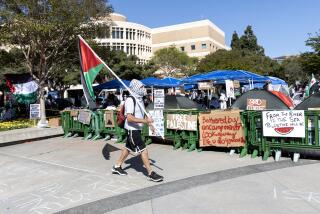Quake Woes Fade as CSUN Classes Start
- Share via
A new generation of Cal State Northridge students began classes Monday, voicing traditional complaints: a shortage of parking, classes and--given the hot weather--motivation.
But for the first time in several years, there were few complaints about the lingering effects of the 1994 Northridge earthquake, which caused $378 million in damages to campus buildings.
CSUN freshmen Riley Baker, Kim Kenyon and Brianna Blum cursed the day’s triple-digit temperatures from the shelter of umbrella-covered picnic tables at the student union.
“This weather is absolute hell,” said Baker, a liberal studies major whose first class of the new school year was public speaking. “They ought to start classes in October.”
CSUN sophomore Lilit Sagatelyan said her main concern was arriving promptly at her astronomy class.
Sagatelyan, sweating and short of breath as she walked, complained she waited more than an hour to find a parking place. “After all this hassle,” she said. “I hope I got all the right classes with a good teacher.”
CSUN officials said they are pleased that students have finally stopped complaining about the earthquake, a sign that the memory of the disaster is fading.
“It’s really, really, wonderful there’s an entire generation of students here who don’t associate the earthquake with CSUN,” said spokeswoman Carmen Ramos-Chandler. “As long as they can get into classes they need, the earthquake means nothing to them.”
Preliminary estimates show the university’s enrollment at 26,000--about 7% higher than the fall semester, 1994--before the quake hit, university officials said.
“Our enrollment is getting to where we want,” said Ramos-Chandler.
“We are trying to make sure that the students can get the classes they need.”
CSUN Associated Students President Joaquin Macias said he is looking forward to another kind of rebuilding.
“The way the school was set up [after the quake] a lot of things were fragmented, there was less time to meet at a central location,” Macias said. “This year we want to build a greater sense of community on campus.”
More to Read
Sign up for Essential California
The most important California stories and recommendations in your inbox every morning.
You may occasionally receive promotional content from the Los Angeles Times.













